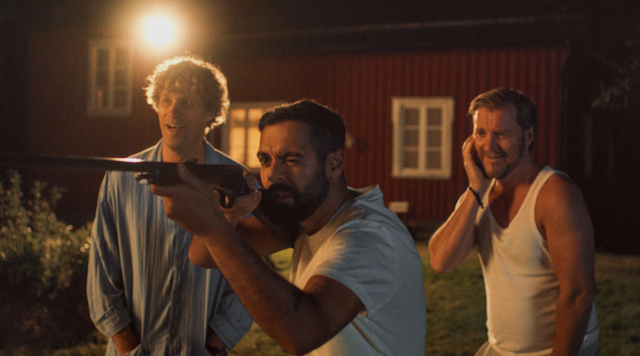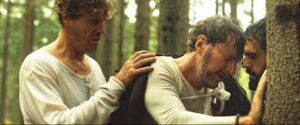
The first-time screenwriter and director Sarah Gyllenstierna with her debut thriller set in the Swedish woods shows a knowledge of men’s psychology way deeper than many of her male colleagues. Focusing on the atmosphere and genre aspect of the movie, she is capable of depicting a universe where all the dark sides and ancestral fears of a contemporary man can progressively surface. The plot of Hunters on a White Field is pretty basic and fit to survival thriller’s topos: three men – two best friends and a younger “rookie” – decide to spend a weekend in a cabin in the woods, hunting any kind of animals they can find. Little by little what was supposed to be a relaxing time between buddies becomes instead a fight for dominance and survival, especially when all the fauna suddenly disappear from the forest…
If the idea at the base of this movie can’t be perceived as original, its development is on the other hand quite mesmerizing. Gyllenstierna does a remarkable job filling the images and lines with many little details that can make the viewer feel slightly uncomfortable, sensing that the drama and the violence are hiding under the surface of words and events. The three characters, so different one from the other, form a microcosm that is quite clearly a metaphor for the whole Swedish society, with its underground prejudices, racism, and a dark pulsion towards isolation and violence. Again, nothing really new about this topic, but nonetheless the movie delivers the necessary tension for the audience to be hooked on the story. Trying to find a link between the contemporary characters and an ancestral way of life that they constantly refer to, Hunters on a white Field shows that masculine culture in Sweden is not something that can be easily eradicated, something that can still bring the single individual towards psychological isolation if not madness.

Using the gorgeous natural landscape as a neutral theater, Sarah Gyllenstierna sets her three characters in a universe that becomes threatening only because human beings are turning it that way. The twisted psychology of the older hunters and successively of the one who’s going to (perhaps) replace them in this chain of violence and anarchy are in some way the poison that turns nature into something hostile and frightening. The sequences in which the three men invade the natural environment and kill the animals thinking that there is an ancient connection between hunter and prey is just a way to show how disconnected from reality those same men are. There’s nothing heroic, nothing wise or charismatic in the protagonists of Hunters on a White Field, only a bunch of men incapable of finding their place in life, forced by their weakness and mistakes to isolate themselves to pretend they still have some kind of power, some value. It is quite clear that since the beginning their words are empty of true significance, their actions dictated by the illusion that there is still some link to the past. It is not true, and the escalating violence that they turn to themselves proves exactly how much some men can be delusional when it’s about truly understanding the meaning of existence.
Except for the very last scene which doesn’t seem coherent with the evolution of the story and the involution of the character, Hunters on a White Field turns out to be a tense thriller/horror with a few scenes of dense symbolism. As very often happens this genre is a tool that, if wisely used, can become a mirror of reality, and
Sarah Gyllenstierna’s film achieves exactly this goal. That is why in the end the events and the situations of Hunters on a White Field are so disturbing. because out there there are real men who could actually make them happen…
Rate: B-
If you like the article, share your thoughts below!
Check out more of Adriano’s articles.
Here’s the trailer of Hunters on a White Field:

